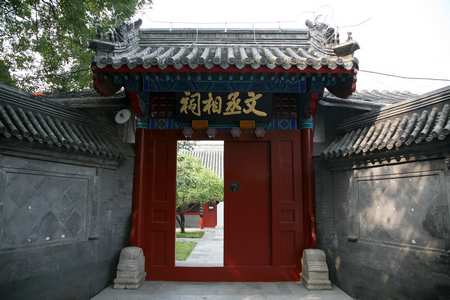Fuxue Hutong: restricted access only!
|
|
|
Wen Tianxiang Memorial Temple. Photo: CFP |
East of Dongsi North Main Street, and west of Jiaodaokou South Main Street, 680 meters of hutong are home to two historical landmarks: Fuxue School, the academic institution for which the hutong is named and the oldest primary school in the city, established in 1369; and a memorial to the patriot Wen Tianxiang, the prime minister whose loyalty to the Song Dynasty during the Mongolian resistance is still remembered today. As a hutong with a multidimensional history, the doors hiding the most interesting nuggets of Beijing history unfortunately are restricted access; only those working or studying within may enter.
A temple fi t for a prime minister
Wen Tianxiang's name is synonymous with loyalty, and while his e¢ orts to protect the Song Dynasty from the Mongolian invasion failed, his faith still remained. He even went so far as to assemble troops with his own funds, but the overthrow of the Song Dynasty was only the matter of time.
In 1279, at the age of 44, Wen was captured and jailed at No. 63; Fuxue Hutong is where Wen spent the last three years of his life. Conditions in this prison were so awful that the cells regularly filled with water from the rain. Every day, Wen jostled with other prisoners for a chance at a bite of spoiled food. Kublai Khan, the first Yuan Dynasty emperor, recognized Wen's talent and even intended to appoint him as prime minister, but Wen was determined to die for his country. After the emperor's repeated attempts at persuasion failed, Wen finally was executed in the west side of the hutong, in 1283.
This 600-squaremeter prison was later converted to a memorial temple during the Ming Dynasty, where Wen's stories are displayed on paper and stone steles. After repeated reconstructions, it's lost the original look, but one can still find a jujube tree in the back yard, supposedly planted by Wen himself. Hundreds of years later, supported by scaffolding, it barely still stands up.
Centuries of school
No. 65, on the east side of the hutong, is the address of Beijing's oldest primary school, the roll it's filled for 600 years. Few people know that, originally, it was Bao'en temple, still under construction when the city was broken by the revolutionary army that later established the Ming Dynasty. Bao'en nearly didn't withstand the transition from the Yuan to the Ming, but clever monks, knowing that Zhu Yuanzhang - emperor of the Ming Dynasty and a Confucius devotee - had ordered soldiers not to enter temples to the philosopher, the monks installed a wooden statue of Confucius to mislead the troops, saving it from destruction.
After 1369, under the emperor's order, the temple became a school administered by Shun Tian Fu, the top official of Beijing. Mao An, a 60-year-old man who has lived here for 20 years, said that the houses inside the school campus were rebuilt about nine years ago to accommodate more students. "Also, some one-story buildings inside were replaced by storied houses," he said. "The whole hutong was meant to be razed as a part of the 'break down for new construction' project, but now it has been preserved [as part of a preserved historical zone] in much of the same layout as when I moved in."
Bonus history!
No. 36, now occupied by the Beijing Municipal Administration of Cultural heritage, was once home to two imperial concubines who left the Forbidden City in 1924. Now, newer, common constructions occupy the old yards. However, No. 36, too, is off-limits to the general public.
 0
0 









Go to Forum >>0 Comments